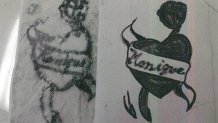The NYPD has unveiled high-tech composite sketches of two people whose murders remain unsolved, and are hoping the public can identify the victims.
Police for the first time used a DNA-based technology called phenotyping to put together predictive sketches of the victims, whose remains were found in Brooklyn in 2005 and in 2015.
In the first case from July 2005, a human torso was unearthed at the Cooper Transfer Facility in East Williamsburg. Police believe the body part was in a dumpster in Clinton Hill before it ended up at the transfer facility.
Four days later, a human skull was found in a garden in Bedford-Stuyvesant. The initial DNA examination found that the torso and skull belonged to the same victim, who police believe was a 17- to 23-year-old man, about 5-feet 5 to 6 feet tall, weighing 130 to 200 pounds.
In the second case, from 2015, two sets of remains were found two months apart in Gravesend’s Calvert Vaux Park, about 1,000 yards from each other. DNA testing confirmed that the body parts belonged to the same person. Police believe the victim was a woman between 20 to 45 years old.

Phenotyping helps police narrow down a person’s physical appearance and even ancestry, according to the NYPD. The method allows investigators to identify victims the way traditional techniques haven’t been able to with limited DNA samples.
Local
Police caution, however, that phenotype composites are scientific approximations of appearance based on DNA -- and they don't take into account environmental factors like smoking, drinking, diet and other factors that can't be predicted by DNA analysis.
Police are still asking anyone with information to call the NYPD Crime Stoppers Hotline at 1-800-577-TIPS. A reward of $2,500 is being offered in this case.




